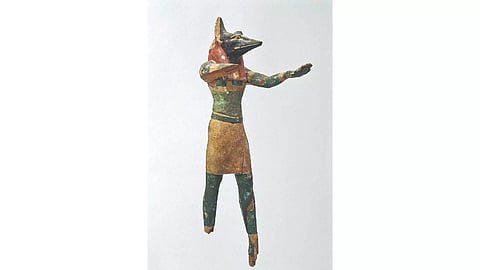

In the mid-19th century, a British antiquarian named Sir Thomas Phillipps announced his intention of owning one copy of every book in the world. A professed “vello-maniac,” Phillipps, a quarrelsome baronet, bought manuscripts indiscriminately from booksellers with whom he engaged in ceaseless battle. Soon there was hardly room in his moldering Cotswolds mansion for his second wife, Elizabeth, who eventually moved to a boardinghouse in Torquay, an English working-class seaside resort. By the time Phillipps died in 1872, he had amassed an unparalleled collection of 60,000 documents and 50,000 printed books.
His descendants auctioned off his private library bit by bit, and by the late 1970s his collection of 19 ancient funerary scroll fragments — each a part of what is today collectively known as the Egyptian Book of the Dead — was acquired by the New York book dealer Hans P. Kraus. Together with his wife, Hanni, Kraus donated the lot to the J. Paul Getty Museum in Los Angeles in 1983. For the last four decades, the writings, which span a period from around 1450 B.C. to 100 B.C., have been stowed in a vault, fragile and easily damaged by light. On Nov. 1, an exhibition at the Getty will present seven of the most representative pieces to the public for the first time. The show will run until Jan. 29.
Rita Lucarelli, an Egyptologist at the University of California, Berkeley, said, “I am glad that the Getty finally decided to disclose and exhibit what has been until now an almost forgotten part of its glorious collection of antiquities, but that contains in fact important specimens of one ofthe most famous ancient Egyptian corpus in the world.”
A standard component in Egyptian elite burials, the Book of the Dead was not a book in the modern sense of the term but a compendium of some 200 ritual spells and prayers, with instructions on how the deceased’s spirit should recite them in the hereafter. Sara Cole, the curator of the Getty exhibition, called the incantations a kind of supernatural “travel insurance” designed to empower and safeguard the departed on the long, tortuous journey through the afterlife. Unlike today’s insurance policies, no two copies were the same.
Despite the book’s title, it was life rather than the afterlife that preoccupied ancient Egyptians, who lived for 35 years on average. “Your happiness weighs more happily than the life to come,” reads one inscription from the New Kingdom period, which lasted from 1550 B.C. to 1069 B.C.
“The texts are a means to assuage your mortal anxiety and control your destiny,” said Foy Scalf, an Egyptologist at the University of Chicago and the editor of the exhibition catalog.
Indeed, the original name for the text translates to the “Book of Coming Forth By Day.” In 1842 the German scholar Karl Richard Lepsius published a translation of a manuscript and coined the name Book of the Dead (das Todtenbuch), which reflected longstanding fantasies about the nature and character of Egyptian civilization. The numbering system he used to identify the various spells is still used today and figures prominently on the Getty’s exhibition panels.
Franz Lidz is a journalist with NYT©2023